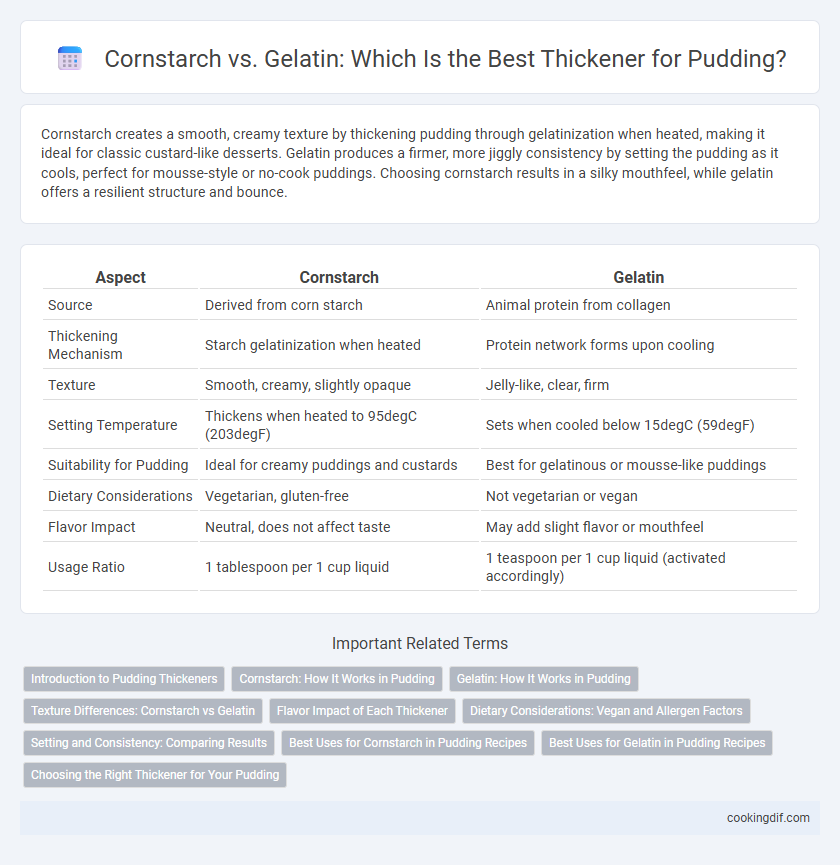Cornstarch creates a smooth, creamy texture by thickening pudding through gelatinization when heated, making it ideal for classic custard-like desserts. Gelatin produces a firmer, more jiggly consistency by setting the pudding as it cools, perfect for mousse-style or no-cook puddings. Choosing cornstarch results in a silky mouthfeel, while gelatin offers a resilient structure and bounce.
Table of Comparison
| Aspect | Cornstarch | Gelatin |
|---|---|---|
| Source | Derived from corn starch | Animal protein from collagen |
| Thickening Mechanism | Starch gelatinization when heated | Protein network forms upon cooling |
| Texture | Smooth, creamy, slightly opaque | Jelly-like, clear, firm |
| Setting Temperature | Thickens when heated to 95degC (203degF) | Sets when cooled below 15degC (59degF) |
| Suitability for Pudding | Ideal for creamy puddings and custards | Best for gelatinous or mousse-like puddings |
| Dietary Considerations | Vegetarian, gluten-free | Not vegetarian or vegan |
| Flavor Impact | Neutral, does not affect taste | May add slight flavor or mouthfeel |
| Usage Ratio | 1 tablespoon per 1 cup liquid | 1 teaspoon per 1 cup liquid (activated accordingly) |
Introduction to Pudding Thickeners
Cornstarch and gelatin are popular thickeners used in pudding to achieve distinct textures and consistency. Cornstarch creates a smooth, creamy, and slightly opaque pudding by gelatinizing starch granules when heated, making it ideal for classic custard-style desserts. Gelatin, derived from animal collagen, sets pudding into a firm, jiggly texture without heat, offering a transparent, delicate finish commonly used in mousse or panna cotta variations.
Cornstarch: How It Works in Pudding
Cornstarch thickens pudding by absorbing water and swelling when heated, creating a smooth and glossy texture. The starch molecules gelatinize around 62-72degC (144-162degF), resulting in a firm yet creamy consistency that holds shape well. Its neutral flavor and clear finish make cornstarch ideal for a wide variety of pudding recipes, ensuring consistent thickness without altering taste.
Gelatin: How It Works in Pudding
Gelatin works in pudding by creating a protein network that traps water, resulting in a smooth, gel-like texture. Unlike cornstarch, which thickens through starch granule swelling and retrogradation, gelatin sets as it cools, providing a firmer and more elastic consistency. This protein-based thickener is ideal for puddings that require a delicate, melt-in-the-mouth finish without the opacity often caused by starch thickeners.
Texture Differences: Cornstarch vs Gelatin
Cornstarch creates a pudding with a creamy, velvety texture that holds shape but remains soft and smooth on the palate. Gelatin yields a firmer, more elastic consistency, offering a jiggly and slightly bouncy mouthfeel distinct from the dense creaminess of cornstarch. The choice between cornstarch and gelatin directly impacts the pudding's mouthfeel, where cornstarch emphasizes creaminess and gelatin emphasizes firmness and elasticity.
Flavor Impact of Each Thickener
Cornstarch provides a mild, neutral flavor that allows the pudding's primary ingredients like chocolate or vanilla to shine without alteration. Gelatin adds a subtle, slightly savory undertone that can influence the overall taste, sometimes creating a richer mouthfeel but potentially masking delicate flavors. Choosing cornstarch ensures a clean taste profile, while gelatin introduces a unique texture accompanied by a more distinct flavor presence.
Dietary Considerations: Vegan and Allergen Factors
Cornstarch is a plant-based thickener ideal for vegan and allergen-friendly pudding, as it contains no animal products or common allergens. Gelatin, derived from animal collagen, is unsuitable for vegans and may cause issues for those with specific dietary restrictions. For allergy-sensitive diets, cornstarch provides a safe, hypoallergenic alternative to gelatin in pudding recipes.
Setting and Consistency: Comparing Results
Cornstarch produces a smooth, creamy pudding with a slightly softer set, resulting in a velvety consistency that holds well but remains tender. Gelatin creates a firmer, more elastic texture, giving pudding a jelly-like set that maintains shape but may feel less creamy. Choosing cornstarch yields a pudding with a delicate, silky mouthfeel, while gelatin offers a more structured, stable result ideal for molded desserts.
Best Uses for Cornstarch in Pudding Recipes
Cornstarch is ideal for creating smooth, creamy puddings with a glossy finish due to its strong thickening power when heated, making it perfect for classic custard-style or fruit-flavored puddings. It works best in recipes that require rapid thickening and a stable texture that holds up well after cooling without becoming rubbery. Cornstarch also enhances the pudding's mouthfeel by providing a silky, velvety consistency that gelatin cannot replicate.
Best Uses for Gelatin in Pudding Recipes
Gelatin is ideal for puddings that require a smooth, jelly-like texture and a firm set, such as mousse or layered desserts, because it creates a delicate, melt-in-the-mouth consistency. Unlike cornstarch, gelatin provides stability at room temperature and prevents weeping, making it perfect for refrigerated or chilled pudding recipes. It is best used in creamy, custard-style puddings where a transparent, glossy finish enhances presentation and mouthfeel.
Choosing the Right Thickener for Your Pudding
Cornstarch creates a smooth, glossy texture ideal for classic puddings, thickening through heat-activated starch granules, while gelatin provides a firmer, jelly-like consistency by forming protein-based gels upon cooling. Choosing cornstarch is best for creamy puddings requiring immediate serving, whereas gelatin suits recipes needing stable, sliceable desserts or those chilled for extended times. Consider desired texture, setting time, and dietary preferences to select the optimal thickener for your pudding.
Cornstarch vs Gelatin for pudding thickener Infographic

 cookingdif.com
cookingdif.com